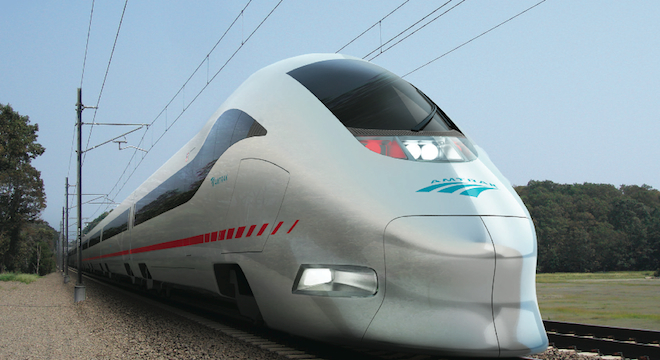Amtrak, the government-owned national rail corporation, on Monday released an ambitious $151 billion plan to develop a high-speed rail line along the currently existing Northeast Corridor rail network by 2040.
The proposed high-speed rail line would travel at top speeds of 220 miles-per-hour in some sections and be able to deliver passengers from Washington, D.C. to Boston in a little over 3 hours.
Travel times between other major Northeastern cities would be shortened even more markedly, with travel times between New York and Boston or New York and Washington, D.C. down to 94 minutes, and a little over a half-hour between New York and Philadelphia.
Compare that to the current fastest Amtrak trains along the route, those in the Acela Express line, which take three-and-a-half hours to get from Boston to New York and a little under three hours to get from Washington, D.C. to New York.
The new Amtrak plan included the following chart showing the estimated time saved as construction on the new plan proceeds over the next 28 years.

“With an expected 30 percent population increase by 2050, we must move beyond mere preservation and rehabilitation of the current system to a new vision for expanded transportation capacity and growth,” said Amtrak President and CEO Joe Boardman in a statement.
But the plan proposes that Amtrak spend the next 13 years making improvements and upgrades to the 457 miles of current rail infrastructure in the Northeast Corridor, which stretches from Washington, D.C. to Boston, before laying down the new track that would be necessary for a high speed rail line.
In fact, Amtrak’s detailed outline, titled “The Amtrak Vision for the Northeast Corridor: 2012 Update Report,” is itself an updated and consolidated version of two other rail plans released by the corporation back in 2010, one focused on improving existing infrastructure and the other on high-speed rail, which Amtrak at that time estimated would cost $117.5 billion.
But securing the funds remains the major hurdle: Amtrak acknowledged in a news release Monday that according to the results of a recent business survey it commissioned, “current Federal, state, and local transportation investment programs are insufficient” and that fare hikes for current service would be one likely option.
Still, Amtrak noted that “public sector leadership and funding is essential during the early years.”
The Federal Railway Administration offered its own less-than-ringing endorsement of the plan on Monday.
“We applaud Amtrak for its planning efforts, which will provide us with useful information as we move forward with our own environmental review process,” said Federal Railway Administrator Joseph C. Szabo in a statement.
Amtrak’s Office of Inspector General in March also released a report that found Amtrak had significantly overestimated the number of riders it would have and the revenue it would raise from acquiring 40 new Accela Express cars beginning this year.
Still, things do appear to be on the right track lately for Amtrak, no pun intended, with the House recently passing a $51.6 billion national transportation and housing bill that gave Amtrak a budget of $1.8 billion, a 27 percent increase from last year.
Correction: This article originally incorrectly characterized Amtrak’s high-speed rail as “shrinking travel distances” when in fact the new trains would merely shorten travel times. The reference has since been corrected in copy and we regret it.






